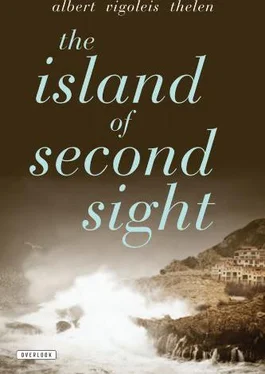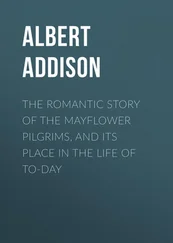We had, as it were, no money. And without money even the most sublimely educated person will revert to the hairiest barbarism, unless he prefers to adopt the glassy-eyed look of an ascetic and simply starve. Our pesetas were just enough for an olla potrida , the popular stew, but not enough for us to buy fuel for an open hearth.
“We’ll consume a historic chair!” Pedro always came up with the right expression. I tugged a chair from the bottom of the pile. It was hard going, but I did it so well that a whole bunch of chairs came plunging down from the top. We had to barricade the door to avoid being buried in an avalanche of furniture.
Since we were lacking a hatchet, Pedro was about to kick the chair apart when I stepped forward to prevent such an irreverent act. I put the chair on the firestone of the capacious hearth, which was separated from the rest of the kitchen by a low partition. I set it afire, using material purloined from Don Juan’s archive of alibis: theater programs from his “Paris” file. Then we began wagering over which direction the burning chair would start to lean. This was exciting business, and we repeated the ritual before every meal. I recall one elaborate chair whose name-tag had been gnawed away. Although it burned with blinding flames, it leaned neither to the right nor to the left, nor did it bend forward or crash down backward, nor did it crumble in on itself. It simply carbonized without losing its shape, leaving only a black skeleton. At the beginning of the process we joked about this special saint getting burned at the stake. But then we turned silent, because things were becoming uncanny. Beatrice, normally so very rational, claimed to espy the outlines of a human figure in the little blue flames shooting out of crevices in the chair. The smell of resin and incense was so strong as to take our breath away.
We concluded that higher forces must be at work here, occult powers that Don Juan held in command by keeping them in chains. It was likely that this poltrona had once borne the weight of the Mallorquin mystic Raimundus Lullius, the originator of the Great Art. Pedro did not dispute this assumption, for the sage Raimundus had in fact frequented the palace and conjured up spirits for the ancestral grandees. Unfortunately, our house did not contain a bell-jar large enough to cover the carbonized skeleton. Otherwise we would have conserved it for posterity. Smaller glass covers called redomas were plentiful in the entrada , containing under their mildewed domes such things as sprigs of myrtle and bridal wreaths, little collections of shells and coral, miniature Stations of the Cross replete with colorful penitent folk, and even more numerous insects, all of them on their way to this Calvary and unable to escape. Death, a common theme in this kind of popular art, had come to these household pests unexpectedly, and now they lay there as if the pious artist had intended all along to include them in his kitschy tragic tableau. Pedro said that the palace servants were very fond of these scenes, and that was why, when Don Juan enjoined everybody to rescue the most important contents of the palace, they had removed them to safety. And anyway, why should a painting by Velázquez have greater value than an insectarium, at a moment when a palace is collapsing? Incidentally — this occurs to me as I write these words — the fall of the House of Sureda coincided with the dethronement of the Bourbon Dynasty. All this feudal magnificence then dried up under a redoma , augmented by the vermin that always find their way to the scene of decay.
We prepared our meals in long-handled pans. Using a copper kettle that hung on a hook over the hearth, we boiled water against typhus and the plague.
We lived this way for three weeks, yanking many a chair out from under the spectral buttocks of some celebrity or other, but we never again got to see one of them in the little blue flames.
On the first evening, when Beatrice was about to wash our dishes, Pedro told her not to bother. We were not on General Barceló Street, he said, but on the Street of Bitterness. He went to the WC, which was separated from the kitchen only by a curtain, opened a little window and tossed the entire set of dishes into the cloaca located far below the house, which was built on a cliff. “We’ve got plenty of dishes. There are more than ten crates full of them in the attic. Papá thought of everything. Let’s not pretend that we’re poor. Take an example from Vigoleis.”
I had tossed a fresh chair onto the embers to warm up a bowl of water for shaving. I wanted to confront the private physician of Ludwig Salvator with a clean-shaven face. Should I bend over and poke through the ashes? I had spent enough of my lifetime in the bent-over position. Now I intended to enjoy life to the full. I had discovered a silver bowl from which, according to the inscription, no less a spirit than Don Gaspar Melchor de Jovellanos had drunk the bitter gall of exile. This statesman, politician, and writer, Mallorca’s greatest exile next to Kessler, had spent part of his incarceration in our cloister. I used the bowl for my shaving water.
“Let’s go!” said Pedro. “Don José is waiting. He knows that I’ll be bringing you along.”
I picked up a knobby rosewood cane with an ivory handle and a whole bunch of tags hanging from it like multicolored ribbons on a guitar. “We’re off!”
“What are you doing with that horrible stick? You’re always making fun of people who use canes, and now you’re going out with one yourself?”
“Beatrice, what you see is no longer a cane. Like everything else here it has long since lost its original function. It is my fly swatter, and it will come in very handy. Here, I’ve found something for you, too.”
I handed her a yellowed pair of unmentionables that, if the labels hadn’t got switched around at the “Pressa” in Cologne, had once enclosed the aristocratic corpulence of Spain’s greatest woman writer, Doña Emilias de Pardo Bazán. “You can use this as a fan when the hot wind blows in from the Teix. Shall we go?”
Don José, private medical consultant to His Royal Highness Archduke Ludwig Salvator of Austria, was also in fact a doctor. He was also an impassioned collector, though he never let his avocation get the best of him. He collected postage stamps, examples of human behavior, and human embryos in the phase of development when they are no longer fetuses. He preferred the embryos of twins and triplets, although he confined himself to these specialties on the basis of availability rather than scientific speculation. Multiple births are rare, and rarer still is the opportunity to put one up in a jar. Don José never got beyond triplet specimens. He was familiar with the Hameln Septuplets, so famous and notorious in the Middle Ages and featured on a fearful broadsheet that we exhibited at the Cologne “Pressa.” But he himself could never dream of obtaining such an impressive rarity to put on his shelf. Nowadays this forward-looking physician would have his little moon-calves encased in plastic. At the time, he was limited to the use of pickle jars from his kitchen, which he sealed with the skin of pigs or fishes. Like the Rhine Maidens, these wee people floated in their bath of alcohol, and it was possible to put the specimens to a test of the principle known as the Carthusian Diver. Anyone wandering into this copa had to be in a good mood, with nerves strengthened to avoid spoiling the appetite. The copa is a pantry adjoining the kitchen, which also serves as the area for preparing meals. Standing next to home-made pickles and delicate aspics, the embryos led their melancholy existence beyond the reaches of space and time, weightless, free of sin, and blissful in their cradling, paradisiac, briny bath. People came and went around them all the time. No sooner had one made the acquaintance of an onion, a truite or a langouste en aspic , when Doña Clara appeared to fetch its neighbor and place on the pantry counter some new, no less succulently prepared dish, which likewise eventually went the way of all earthly things. All that was left over was us.
Читать дальше












